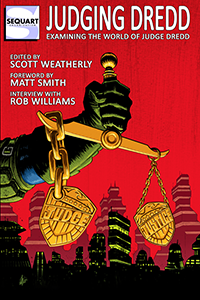The next stop on our tour of British comics focused on disenfranchised teens/twentysomethings in the late ‘80s and early ‘90s brings us to True Faith, a smart, satirical, dare I say sometimes even poignant look at religious hypocrisy, anti-religious hypocrisy, school cliques, zealotry, property destruction, the redemptive value of blasphemy, and navigating the turbulent waters of late adolescence/early adulthood in the hopes of maybe, just maybe, figuring out who you really are and where you fit into this crazy, mixed-up world of ours.
Among other things.
The brainchild of a couple of guys who would definitely “graduate” to bigger and better things named Garth Ennis (who was only 20 at the time) and Warren Pleece (who was only slightly older), the strip debuted in issue number 29 of Crisis (cover-dated October 1989), a semi-political magazine-format comics anthology series overseen by former 2000 A.D. editor Steve McManus that sought to provide something of a more “realistic” and topical alternative for readers who felt that they’d outgrown the ultra-violent escapades of Judge Dredd, Rogue Trooper, Slaine, Sam Slade Robo-Hunter and their ilk. Crucially, though, Crisis followed the lead of its (older) sister publication and by and large didn’t take itself too seriously (although there were certainly exceptions to this)—and that light(ish)- hearted attitude probably helped contribute at least a little bit to the greater longevity it enjoyed in comparison to other like-minded periodicals.
Okay, sure, 63 issues may not seem like a tremendously long run, but when viewed against mags like Revolver (which lasted all of six issues) and Blast!(which survived for a whopping eight), both of which essentially mined similar territory and played to a similar demographic, you’d have to say that Crisis enjoyed a reasonably healthy run—and may have been able to stick it out even longer if British comics in general weren’t undergoing a drastic period of contraction in the late Thatcher/early Major years. Oh, and since we’re on the subject of Thatcher, it’s probably worth pointing out that while she’s not nearly the central figure in this story that she was in the just-examined-in-this-series St. Swithin’s Day, she does put in an appearance—proving that she was at least good for, if nothing else, serving as a kind of universal figure of villainy for young UK comics creators at the time.
I use the term “UK” with precision in this case, given that Ennis is from there, but is most assuredly not British. Nor is he Scottish. Or even Welsh, for that matter. Nope, our guy Garth hails from the rough and tumble streets of Belfast, Northern Ireland, and at the time True Faith was “green-lighted” for publication, he had exactly one previous professional credit on his resume: Troubled Souls, a unique combination of political drama and drunken comedy done in collaboration with artist John McCrea that had also run in the pages of—wouldn’t ya know it? —Crisis.
That strip had proven to be something of a “breakout” success for both of its creators, and would soon be followed by a sequel entitled For A Few Troubles More (an obvious hat-tip indicating Ennis’ fondness for Sergio Leone/Clint Eastwood “spaghetti westerns”), with True Faith seeing the light of day in between the two “troubled” series. Viewed though a purely historical lens, then, it would be tempting to brush off the church-burning antics of “outsider” youth Nigel Gibson and mentally unhinged toilet-products salesman Terry Adair as something of a “stopgap” measure spacing out the front and back ends of Ennis’ ultimately longer-form narrative with McCrea, but in truth, many of the themes touched on in True Faith would go on to be hallmarks that its co-creator frequently returned to, most explicitly in his and Steve Dillon’s runaway hit Vertigo series Preacher.
As a matter of fact, so obvious were the parallels between the two works that Vertigo re-issued True Faith in collected “graphic novel” format in 1997 (shown above, with the cover for its original collected edition from Fleetway/Quality in 1990 reproduced at the top of this article), right at the very height of Preacher’s popularity and notoriety. At this point, though, I might be getting just a little bit ahead of myself, so let’s table a more detailed examination of the True Faith/Preacher similarities at least until our next segment, whereupon well begin a more detailed examination of the story proper.
Sound good? Okay, cool—thanks for being so agreeable.
We’ll close out this admittedly brief introduction to the strip, then, by asking those of you—assuming there are any—who choose to follow along at home to keep in mind that although the story does, in fact, delve into some fairly weighty and relevant topics, that Ennis and Pleece quite obviously have their tongues firmly planted in their cheeks more or less from start to finish here, and therefore you’re actually likely to get more out of the strip by choosing to never take things too terribly literally yourself. There’s a fair amount of outrageousness for its own sake going on here, and that’s actually one of True Faith’s greatest charms. Yeah, sure, there’s plenty on offer to think about as proceedings unfold, but don’t forget to have fun, too, since the creators clearly were having plenty of it themselves.
With all that out of the way, then, I’ll simply exit stage left by saying that I hope to see you back here in a handful of days for the first part of our reasonably-thorough, blow-by-blow post mortem of this uniquely irreverent semi-masterpiece!























































